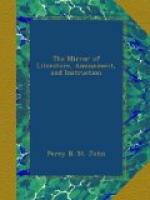The present castle was built at different periods. The north-east end, which was erected by Sir Charles Cavendish, about the year 1613, is the oldest. The interior of this portion is uncomfortably arranged. The rooms are small, and the walls are wainscoted, and fancifully inlaid and painted. The ceilings of the best apartments are carved and gilt, and nearly the whole of the floors are coated with plaster. There is a small hall, the roof of which is supported by pillars; and a star-chamber, richly carved and gilt. The only comfortable apartment, according to Mr. Rhodes, is now called the drawing room, but was formerly the pillar-parlour, from its having in the centre a stone column, from which springs an arched ceiling, while round the lower part of the shaft is a plain dinner-table, in the right chivalric fashion. From the roof of this building, to which the ascent is by winding stairs, the view extends “till all the stretching landscape into mist decays.” The garden beneath is surrounded with a wall about three yards thick, and contains an old fountain of curious and expensive workmanship, which Dr. Pegge, (who was a native of Chesterfield, and wrote a history of Beauchief Abbey,) has laboured to prove very beautiful.
Hitherto we have spoken but of that part of Bolsover Castle which was formerly denominated the Little House, to distinguish it from the more magnificent structure adjoining. This immense fabric, whose walls are now roofless and rent into fissures, was built by William, the first Duke of Newcastle, in the course of the reign of Charles ii., but is said never to have been entirely finished. The interior walls are but bare stones; the door and window cases, and the different apartments, are of unusually large dimensions, the principal remaining apartment being 220ft. by 28: the entire western part, including the Little House at the northern extremity, extends about 150 yards. The designs for the whole castle are said to have been furnished by Huntingdon Smithson, (an architect noticed by Walpole,) but he did not live to witness its erection. He collected his materials from Italy, where he was sent by the Duke of Newcastle for the purpose. Smithson died at Bolsover, in 1648, and was buried in the chancel of the church, where there is a poetical inscription to his memory, in which his skill in architecture is commemorated.
The whole pile is now wearing away. Trees grow in some of the deserted apartments, and ivy creeps along the walls; though the ruins have little of the picturesqueness of decay. The best point of view, or north-west, is represented in the Engraving; a short distance hence lies the village of Bolsover.
[1] The duke was an important
personage in the hostilities between
his
soverign and the parliament. In 1642, he was appointed
general
of all his majesty’s forces, raised north of
Trent,
with
very full powers. He levied a considerable army




